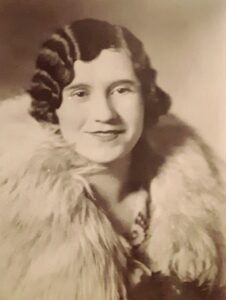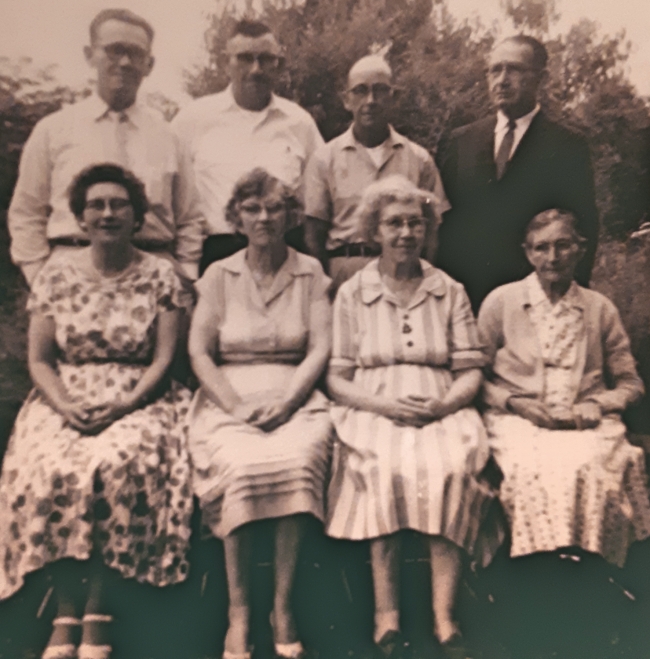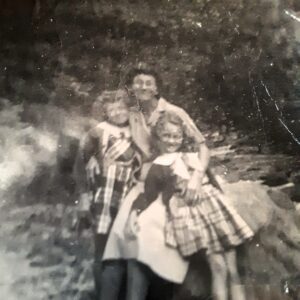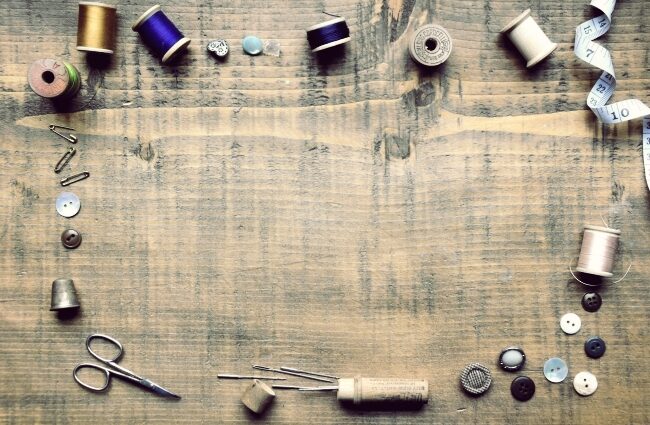I keep Great-Aunt Bonnie’s sewing box tucked away in a closet. Mama gave it to me long ago after Bonnie died. It isn’t really a box at all, but a big Christmas cookie tin. The tin is round and red with touches of yellow and green. A scene painted on the lid is of a cozy farm house—a brick fireplace, a rocking chair, a sleeping dog, and an idle loom in the corner. The tin has held up well for its age—maybe sixty years or better.
My great-aunt was born in the early 1900s in Burnsville, North Carolina, and was the youngest of thirteen children. Later, her family crossed over the Unaka Mountains into East Tennessee. When she grew up, Bonnie worked at Bemberg Textile Factory in Elizabethton, living with her parents and bringing them her paycheck.

I have a photograph of her taken when she was young, all 1920s stylish. Her dark hair is crimped in bobby pin waves, and she wears a big furry-collared coat. Her eyes look dreamy and a small smile plays on her lips.
Bonnie probably sewed all her life. She inherited her mother’s trestle sewing machine, and most likely learned crocheting and quilting and other needlework from her mother. I suspect Bonnie bought most of her sewing materials in Unicoi County, Tennessee, where she grew up and lived most of her life. Erwin’s a small hamlet, the old hunting ground of the Cherokee Indians, and is surrounded by the Blue Ridge Mountain chain, part of the Appalachians. One feels lost in time in Erwin: the few stores stand mostly empty or boarded up, and the streets feel haunted, as if a ghostly wind swept through the village.
I threw away many items in the sewing box, but left many needle packets. An old Singer one reads, “Fifty hand needles, assorted sizes/types: darners, embroidery sharps, betweens, tapestry.” A faded price sticker says the needles came from Eckerd’s and cost $1.60. The inside of the small package fades to light brown, and only a few needles remain, symbols of an era when needles were valued and necessary. I imagine Bonnie’s gray head bent over an old patent leather purse, digging for change that she lays carefully on a drug counter.
I find four thimbles in the sewing box. Two are silver, one is bronze, and one has a turquoise stripe. I try to visualize Aunt’s index finger pressed through one of the thimbles, pushing her long life as hard as she could to persevere through the difficult times.
Another needle case advertises the National Life and Accident Insurance Company. It is shaped in a red square with a blue shield that states, “Tomorrow is the reason you should buy insurance today.” Insurance companies insure some things, certainly, but cannot really shield one from the cares of the morrow, as Aunt Bonnie surely knew.
I find a match cover needle case that Bonnie collected from the Erwin Launderama on North Main Street. A caption on the back reads, “Your clothes will fall in love with our machines.” Perhaps, Bonnie often visited the laundromat, waving a smile and a hello to some tall, strong-armed woman, sleeves rolled up, wringing wet clothes into a porcelain sink.
Another blue needle case commemorates the turn of the century with a small U.S. flag and reads “Long May it Wave 1976-1776.” At around seventy-five at that time, Aunt Bonnie would have endured two world wars, food shortages and rationing, the Stock Market Crash and Great Depression, and the 1918 Flu Epidemic. She would have lived through Prohibition, the passage of the 19th Amendment, the introduction of the telephone, the Korean and the Viet Nam Wars, Watergate, political assassinations, and many Presidents. All this time, she had spun straw into gold, so to speak, with only a few straws to spin. Appalachian women, whether single or widowed, or with idle or drunken husbands, knew how to live on virtually nothing but common sense and hoarded pennies.
I like to think that Aunt Bonnie found refuge in her handwork and in collecting small, often free, items. Though she lived her later years mostly in solitude in a quiet little town nestled next to high mountains, I believe she did so with good cheer and forbearance. And although she was tucked away into a dim cubby hole with faded wallpaper and ragged rugs, she accepted the life the universe saw fit to give her, piecing together the few opportunities and pleasures of a simple life in the same manner she did with her quilt squares.

Aunt Bonnie fell and broke her shoulder when she was older, and my mother took care of her. In recovery, Bonnie whispered to my sister Sandy, “Mayme is rough as a cob,” meaning Mama rather manhandled Bonnie’s sore shoulder. Bonnie might have gained some of her patience and wisdom from her needlework, and learned how to handle fragile things gently. Sewing requires careful stitching, easing the needle through fabric so as not to pucker or tear the precious material — much like caring for the sick or raising children. I remember my mother fussing at me when I was little, and Aunt Bonnie calling to her, “Oh, Mayme, let her be a young’un.” Bonnie knew how to wield a needle carefully and with sensitivity.
When Bonnie was 90, my mother went with her to the doctor’s office. The doctor told Bonnie she had cancer. In a mild tone, Aunt just said, “Well.” Bonnie knew to yield to death when it came; by this time, her parents and all her twelve siblings had passed away, leaving her much like needles in an empty Singer’s package.

She and my sister Sandy are a lot alike, I realize. Neither had children and were widowed from husbands that were not much account. Regardless, these women managed to craft quiet, creative lives within small spaces with patience and faith. Although they leave behind only a few stray threads and rusty needles materially, they also leave priceless parting gifts—lessons of courage and grace, bequeathing tiny sparks of steeliness, and not just from their sharps, the “go to” needle for basic mending of a worn and torn life. For steel in their needles aligned perfectly with the steel in their spines, as steel is prone to find its way into the quiet, unassuming, gentle ones, such as quaint old ladies living in small, sleepy Appalachian towns.
Susan Evans currently lives in Baltimore, Maryland, but grew up in eastern Tennessee. She came from a big, sprawling family that migrated from Yancy County, North Carolina, in the 1800s, and fanned out on the other side of the Unaka Mountains into the Volunteer State. She is published in many online and print magazines and journals.

What a lovely tribute to a lovely woman. I really enjoyed this tribute.
Thank you very much.